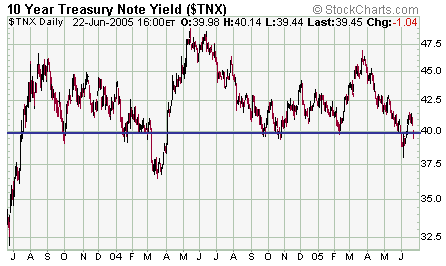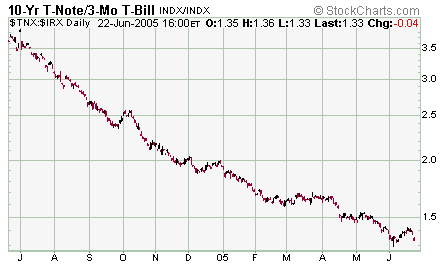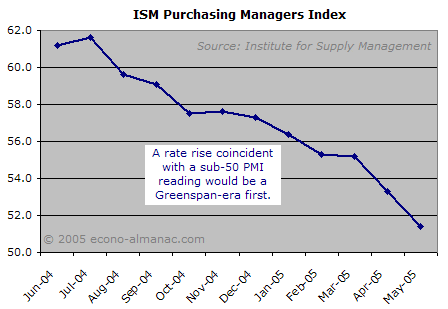As I’ve prattled on about endlessly, generational-low interest rates are a critical element in allowing San Diego home prices to remain so high compared to incomes. One cannot, therefore, gauge the health of the real estate market without understanding the health of the credit market.
Not that it’s terribly easy to do so—the greatest financial minds in the world cannot seem to agree with each other about what drives the bond markets and where yields will go. As a matter of fact, they can’t even agree with themselves.
Long-Term Rates
Last month, PIMCO’s Bill Gross reversed his long-held bearish* stance on the bond market, opining that the 10-year Treasury yield (currently at 3.95%) will remain between 3% and 4.5% over the next 3-5 years. Gross is known as “the Warren Buffett of bonds” and manages $500 billion worth of assets through his company’s various bond funds. He may well be the world’s biggest investor, and he is certainly among its most successful, so his opinion is ignored at one’s own peril.
(*Those who are familiar with the bond market can skip this paragraph, but for those who aren’t: bond prices and yields have an inverse relationship. As one rises, the other must necessarily fall. As an example, if you are holding a bond that yields 4%, and bond market yields go down to 3%, your bond just rose in value by 33% because its yield is 33% greater than what the rest of the market is offering. Hence, being “bearish” on bonds means that you feel that bond prices will go down and yields will go up.)
Morgan Stanley’s highly regarded chief economist Stephen Roach, also preaching an imminent yield increase up until recently, had a similar change of heart and now believes that bond yields will stay low “for the foreseeable future,” with a chance of drifting even lower.
And the market doesn’t seem to disagree. The yield on the 10-Year Treasury Note, which tracks very well with fixed-rate mortgage yields, is as low as it’s been for over a year.

Short-Term Rates
Unlike long-term rates, which are set by supply and demand on the global bond market, short-term rates are heavily influenced by the Federal Reserve. As I explained in A Bubble Primer Volume 3, the Fed raises and lowers their short-term target rate in order to encourage (when they lower the rate) or slow down (when they raise the rate) excess lending and borrowing. They have been raising for over a year in an attempt to tighten up the lending environment, and short-term bond yields have followed suit:

Divining what the Fed might do is valuable to us for two reasons:
- Short-term lending rates are closely correlated with the Fed’s target rate. When ARMs comprise 80% of the new loans being issued, continued Fed raising could have a notable effect on ARM activity.
- When the Fed raises short-term rates, long rates usually follow. This has not yet happened during the current tightening cycle, but it’s worth noting as a potential risk to long-term rates staying low.
Most Fed watchers—and most Federal Reserve members themselves— maintain that the Fed will hike rates throughout the remainder of the year. Despite this, there are several reasons to believe that the Fed may be near the end of its tightening cycle:
- If long-term interest rates stay low or move even lower as the Fed continues to raise short rates, there is a risk that the yield curve could invert (meaning that long-term rates could become lower than short-term rates). There is no more reliable indicator of impending recession than an inverted yield curve: whenever short rates have risen above long rates, in recent history anyway, a recession has followed within 18 months.
It is highly unlikely, then, that the Fed will allow the yield curve to invert. And since long rates are declining despite all their efforts to the contrary, the only way for the Fed to avoid a yield curve inversion will be to stop hiking short rates. The following chart, which displays the yield on the 10-year Treasury divided by the yield on the 3-month Treasury, indicates that the ratio is 1.33, down from almost 4 a year ago.

A drop below 1 would indicate a yield curve inversion, and as you can see, we are perilously close. Unless long rates start rising, the Fed is unlikely to cut rates much more.
-
The Institute for Supply Management’s Purchasing Managers Index seems headed towards 50. This index measures activity in the manufacturing sector and is viewed as an important gauge of the US economy.
Readings below 50 indicate a contraction of the manufacturing sector, and perhaps unsurprisingly, the Fed doesn’t tend to raise rates when this crucial part of the economy is shrinking. As a matter of fact, at no time during Greenspan’s 18-year tenure has the Fed raised rates while the ISM Index was below 50. As you can see from the following chart, a sub-50 reading certainly looks to be in the cards soon enough. While there is of course no rule stating “don’t raise rates while the manufacturing sector is shrinking,” the correlation is worth noting, especially in light of the yield curve issue mentioned above.

- Sweden’s central bank just cut rates, and there are rumblings that the European Central Bank (stewards of the Euro) will follow suit. Such a move by the ECB would make US rates higher relative to European rates, reducing pressure for the Fed to keep raising.
Conclusion
Bond market developments in the last couple months have been quite bullish for the short- to medium-term health of San Diego’s real estate market. Long rates appear set to stay low for the time being, and the Fed may surprise everyone by keeping short rates lower than expected.
So the bond market, like the local economy, is sounding the all-clear for now, and prices look to remain pretty steady for the time being. And—I can’t believe I’m saying this—if the Fed actually starts lowering rates much earlier than expected, the market could even get a second wind and start upwards again. Needless to say we’ll be watching the credit markets carefully for clues.
Those of you who are interested in “getting under the hood” should check back next week for a two-part article on what’s driving the bond market, why yields are so low, and what could cause yields to start rising.
Treasury yield charts courtesy of StockCharts.com.
